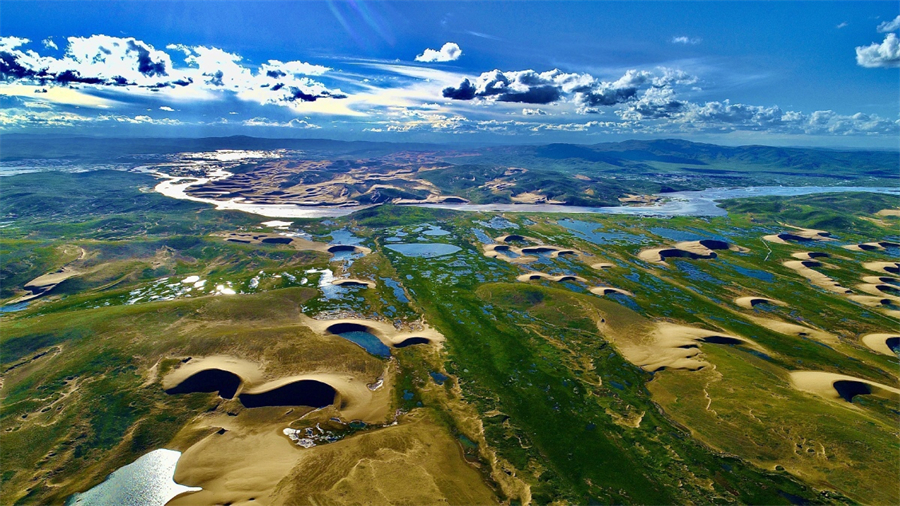Monitoring ensures water protection

An aerial photo of Sanjiangyuan National Park in Northwest China's Qinghai province. [Photo provided to China Daily]
XINING — There are not many places on the planet where you can see black-necked cranes roosting in wetlands, and more than 200 sheep grazing on a hillside, with the ribbon of a majestic river snaking in the distance, but on the live feeds of a ecological monitoring system in Sanjiangyuan area in Northwest China, you can.
Sanjiangyuan contains the headwaters of the Yangtze, Yellow and Lancang rivers.
The system is composed of video cameras at various observation spots, a private network that allows realtime video feeds, and a management platform, forming an important part of the ecological monitoring network in Sanjiangyuan.
In recent years, China has strengthened the protection of water resources as part of its efforts to build a green, beautiful and sustainable future. In the process, the latest technological innovations have played a big part in boosting the efficiency and effectiveness of the management of water resources.
The Yushu Tibetan autonomous prefecture in Qinghai province, which administers a part of the Sanjiangyuan area, delivers an average 29.7 billion cubic meters of freshwater to downstream regions every year. It is home to the world's most primitive and largest alpine ecosystem, where glaciers, snowcapped mountains and high-altitude wetlands play a key role in the conservation of river headwaters.
Yushu has in recent years spent more than 8 million yuan ($1.2 million) building the monitoring system, said Dorga, head of the Yushu ecology and environment bureau, adding that 35 observation points have been set up in the prefecture.
"The system has effectively provided on-site observation and analytical tools for water source protection, solving the problems of slow response, high cost and limited coverage associated with human patrols," Dorga said.
In the north of China, the Haihe River, dubbed the "mother river" of Tianjin municipality, plays a crucial role in the city's flood discharge, water storage and urban environment.
After placing a white unmanned boat about a meter in length on the Haihe River, Mei Pengwei can monitor the sonar images sent back to a laptop as the boat heads toward the middle of the river.
Mei works in the Tianjin Eco-Environmental Monitoring Center. Since 2019, Mei and his colleagues have been routinely monitoring the conditions of the Haihe River and its tributaries.
In 2017, the water quality of 12 rivers in Tianjin, including the main stream of the Haihe River, was graded below Class V, which means too polluted for any purpose, including irrigation.
In recent years, the local government started a campaign targeting water pollution by using advanced devices, including unmanned ships equipped with sonar, unmanned aerial vehicles and satellite remote sensing.
"As some parts of the river are hundreds of meters wide with marshes and grass on the banks, it is very hard for our monitors to get into the river," said Gao Kai, senior engineer at the monitoring center.
According to Gao, UAVs can provide realtime photos or videos of the river conditions and locate pollution on the river surface, while unmanned ships are able to locate underwater sewage pipes through sonar detection.
After a suspected case of pollution is detected, monitoring experts rely on satellite remote sensing for information about nearby enterprises, residential areas and business districts, before making field trips to pinpoint the source of the pollution.
"With the help of technology, we have conducted pollution source investigations, while also monitoring water quality and aquatic biology in a more accurate and effective manner," Mei said.
The water quality of the 12 rivers in Tianjin has significantly improved, upgrading to class IV in general, which mean they are suitable for agricultural and certain industrial uses.
The development of mobile technology has provided environmental regulators, as well as members of the public, with a powerful and handy tool to tackle environmental violations.
In Xiangtan city, Hunan province, local authorities have promoted a new and modern system of water resources management, which relies heavily on mobile technology.
They have taken the lead in the province in developing an electronic map of the city's water system and a mobile app called "Smart Water Management", which allows one to easily monitor the river with just a few taps.
Zhang Chaoqun is a river chief in charge of an 8.8-kilometer section of the Xiangjiang River, which flows through Xiangtan. He has been patrolling the section every day since 2017.
Every time he detects a problem, such as river pollution or illegal fishing, Zhang takes a photo on the spot and uploads the information through the mobile app. After government administrations investigate and solve the problem, he receives feedback on the app.
"The app is very convenient. Violations are usually redressed within five working days," Zhang said, adding that it helped river chiefs like him carry out their duties.
Xinhua
























